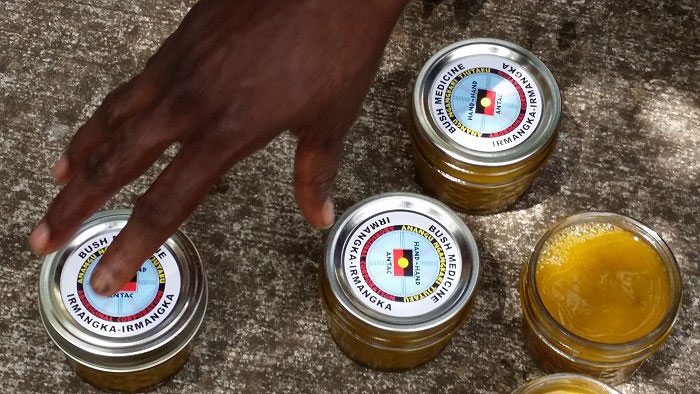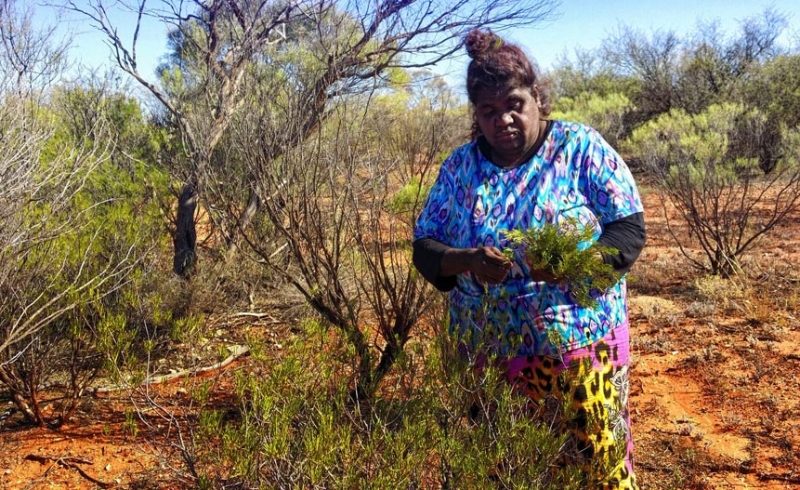Healing hands
A corporation with a vision to strengthen traditional healing and make it part of a complementary, ‘two-way’ healthcare system
Aṉangu Pitjantjatjara Yankunytjatjara (APY) lands, South Australia: In 2012, a group of Aboriginal traditional healers—ngangkaṟi—from the APY lands came together with a mission to strengthen traditional practices and medicines, and a vision for a complementary, ‘two-way’ healthcare system.

Aṉangu Ngangkaṟi Tjutaku Aboriginal Corporation (ANTAC) promotes health and wellbeing among Aṉangu people and their communities, and provides healing services and educational programs for local people—Aboriginal and non-Aboriginal—and whoever else requests them. Members of the corporation—of whom there are now 20—are all ngangkaṟi, accredited in accordance with Ngangkaṟiku Tjurkupa (customary law). The corporation is governed by five directors and the board always comprises at least two ngangkaṟi men and two ngangkaṟi women. As well as providing healing services, its mission is to sustain and strengthen ngangkaṟi skills—among its members but also among ngangkaṟi children as they grow and learn.
A traditional approach to healing

Rama Simpson (left) and Cyril McKenzie
The ngangkaṟi approach to health and wellbeing is very different from the Western medical approach. Rather than focusing on the part of the body that is ailing, ngangkaṟi focus on the person’s spirit. To identify the problem they look inside—with ‘a kind of xray vision’, is how one patient described it.

Sometimes they see something that shouldn’t be there. ‘I remove foreign bodies from people; make them better,’ says corporation member Cyril McKenzie, from Ernabella. And sometimes the person’s body and spirit have become separated and need reuniting:
Yeah sometimes spirit got out from the body. Sometimes they hide around in the back. Well, what if the spirit go out from the body? You better look around for a ngankaṟi for this. That’s our job. So it’s not … doing operation or giving a medication … If someone lost their spirit, the healers, ngangkaṟi … they grab it, bring it back, and we always put it back in their body, so they can feel okay.
Patients tend to describe their experience with ngangkaṟi in spirit terms, such as feeling ‘freed up’. But the healing can also have profound physical effects, such as restoring function and ease to knees that have long been stiff and painful, relieving headaches, muscular tensions, or stopping a baby’s persistent cough. And a large part of the ngangkaṟi practice is absolutely tangible, involving massage and bush medicine balms. ANTAC director Debbie Watson, from the Fregon community, puts her work in simple terms, ‘When people get sick, we take away the pain. We see it inside our mind.’
A complement to national healthcare

Dr Panzironi (left) with ANTAC directors and members (left to right): Mukayi Baker, Debbie Watson, Sam Watson, Cyril McKenzie
Dr Francesca Panzironi is a researcher into Indigenous traditional medicine and its harmonisation with national health-care systems. She helped establish ANTAC and now works as its CEO. Dr Panzironi describes how ngangkaṟi sits in relation to mainstream medicine:
From a western scientific point of view… there is no conceptual framework to encompass this kind of diagnosis and assessment. However, this is what the ngangkaṟi see, this is what they do, and people’s reaction is very positive. There were a couple of patients yesterday who said they were feeling the energy getting back into their body. They came very down and depressed, and they left very happy.
ANTAC’s Aboriginal traditional healers work in hospitals, Aboriginal community controlled health centres, mental health units, prisons, rehabilitation and palliative care centres. As well as responding to local demand, members of the corporation also travel interstate to hold healing workshops in cities and regional centres. In the last few months, Dr Panzironi has travelled with ANTAC ngangkaṟi to many places in South Australia, New South Wales, Victoria and Western Australia. At each destination, ngangkaṟi have been in high demand, and in December 2016 the corporation won a Port Adelaide Enfield Council award for its contribution to the community.
Activating the traditional healthcare workforce

Ms Watson would like to see Aboriginal traditional medicine practised in every health centre and hospital throughout Australia. Her vision is not to replace western medicine, but to complement it, so that what’s offered together is made stronger:
If someone is in the car and has an accident, spirit is in the car and the doctor can’t help. If they die in the hospital, the spirit is left behind. Spirit is the main one for every people in the world. Spirit we need to look after it.
Dr Panzironi envisions the inclusion of Aboriginal traditional medicine within the national health care system through a two-way health care model.

Aboriginal traditional healers hold a body of knowledge and practice that qualify them as legitimate traditional health care practitioners who can work hand-in-hand with the mainstream health care professionals
There is a qualified Aboriginal health workforce, waiting just to be employed. ANTAC is committed to creating an employment pathway for qualified Aboriginal traditional healers as a legitimate healthcare workforce, because this is who they are.
Mr McKenzie is just one of ANTAC’s 22 members, and he’s been healing people since he was a young child:
Yeah it’s hard work. It’s a good job, to be a healer. Looking after people: old people, and young ones, babies, any colour, black and white.
Background
For more information see antac.org.au or facebook.com/antac.ngangkari
For this story, as well as speaking with Dr Francesca Panzironi and Ms Debbie Watson, we used ABC radio interviews with Mr Cyril McKenzie and various ngangkaṟi patients published in:
- Spirits in the balance: ngangkaṟi healers
- The Doctor Man’s lair: a sonic journey with Anangu ngangkaṟi
Photos courtesy of Anangu Ngangkari Tjutaku Aboriginal Corporation (ANTAC).